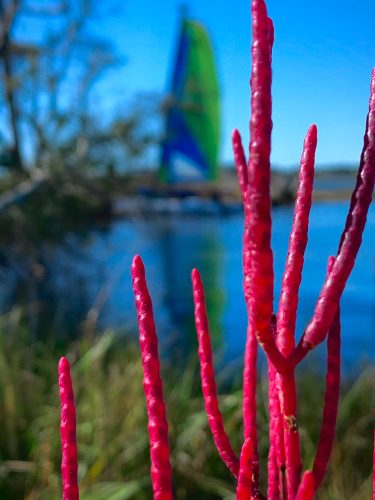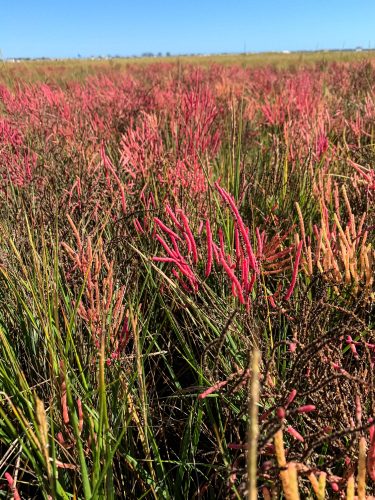When wanting to experience fall colors, the first eco-system you think of usually isn’t the salt marsh. However, it is home to one of the most spectacular autumnal transformations in our area.
Salicornia, a small succulent herb, grows among the salt marsh grasses all summer long. The different greens of the marsh blend and you have to look closely to pick it out. But by mid-September, Salicornia decides it’s through being a wallflower.
The hot pink starts at the tips of its tubular, fleshy leaves dabbed on, like little, dainty fingernails. The color deepens as it spreads through the plant—fuchsia, crimson, ruby. And before dropping off, the “leaf” becomes the color of a fruity merlot.
This color display takes place in the fall, but it’s not necessarily because of the decrease in sunlight and cooler temperatures. It’s the plant’s ability to survive in the saltwater environment that causes the change. The plant takes up the salt water through its roots but then removes the salt and stores it as a briny solution in special chambers in the stem segments. Once these segments become full of salt, they turn red and drop off. Voila, no more salt!
Before Salicornia turns red, the rumor is that it’s edible. In fact, it is a delicacy in some places. Also known as pickleweed, sea beans, and sea asparagus, its saltiness and crunchiness makes it a good addition to a salad. Or as a salad in its own right. Butterfly and moth larvae feed on it during the summer. Ducks, thrush, rabbits, and field mice all dine on its seeds. And, because of its high oil and protein content, it has been used as a forage crop for livestock.
So this fall, instead of cruising Skyline Drive or traveling to Vermont for leaf peeping, hop in a kayak and enjoy the eye-level show in the salt marsh!
by Jenifer Adams-Mitchell
Resources:
https://en.wikipedia.org/wiki/Salicornia
https://www.ncbi.nlm.nih.gov/pmc/articles/PMC4835422/
https://besjournals.onlinelibrary.wiley.com/doi/10.1046/j.0022-0477.2001.00607.x
https://www.aquariumofpacific.org/onlinelearningcenter/species/pickleweed



